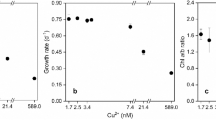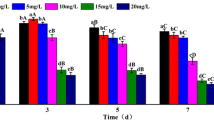Abstract
The toxic effects of Cu (II) on the freshwater green algae Chlorella vulgaris and its chloroplast were investigated by detecting the responses of photosynthesis and oxidant stress. The results showed that Cu (II) arrested the growth of C. vulgaris and presented in a concentration- and time-dependent trend and the SRichards 2 model fitted the inhibition curve best. The chlorophyll fluorescence parameters, including qP, Y (II), ETR, F v /F m , and F v /F 0, were stimulated at low concentration of Cu (II) but declined at high concentration, indicating the photosystem II (PSII) of C. vulgaris was destroyed by Cu (II). The chloroplasts were extracted, and the Hill reaction activity (HRA) of chloroplast was significantly decreased with the increasing Cu (II) concentration under both illuminating and dark condition, and faster decline speed was observed under dark condition. Activities of superoxide dismutase (SOD) and catalase (CAT) and malondialdehyde (MDA) content were also significantly decreased at high concentration Cu (II), companied with a large number of reactive oxygen species (ROS) production. All these results indicated a severe oxidative stress on algal cells occurred as well as the effect on photosynthesis, thus inhibiting the growth of algae, which providing sights to evaluate the phytotoxicity of Cu (II).









Similar content being viewed by others
References
Bernal M, Ramiro MV, Cases R, Picorel R, Yruela I (2006) Excess copper effect on growth, chloroplast ultrastructure, oxygen-evolution activity and chlorophyll fluorescence in Glycine max cell suspensions. Physiol Plant 127:312–325
Bilger W, Björkman O (1990) Role of the xanthophyll cycle in photoprotection elucidated by measurements of light-induced absorbance changes, fluorescence and photosynthesis in leaves of Hedera canariensis. Photosynth Res 25:173–185
Box A, Sureda A, Terrados J, Pons A, Deudero S (2008) Antioxidant response and caulerpenyne production of the alien Caulerpa taxifolia (Vahl) epiphytized by the invasive algae Lophocladia lallemandii (Montagne). J Exp Mar Biol Ecol 364:24–28
Bradford M (1976) A rapid and sensitive method for the quantification of microgram quantities of protein utilizing the principle of protein-dye binding. Anal Biochemistry 72:248–253
Branquinho C, Brown DH, Catarino F (1997) The cellular location of Cu in lichens and its effects on membrane integrity and chlorophyll fluorescence. Environ Exp Bot 38:165–179
Braun E, Aach H (1975) Enzymatic degradation of the cell wall of Chlorella. Planta 126:181–185
Caplan JF, Kumar AS, Park E, Padmanabhan MS, Hoban K, Modla S, Czymmek K, Dinesh-Kumar SP (2015) Chloroplast stromules function during innate immunity. Dev Cell 34:45–57
Choo K-S, Snoeijs P, Pedersén M (2004) Oxidative stress tolerance in the filamentous green algae Cladophora glomerata and Enteromorpha ahlneriana. J Exp Mar Biol Ecol 298:111–123
Cid Blanco Á, Herrero López C, Torres E, Abalde Alonso JE (1995) Copper toxicity on the marine microalga Phaeodactylum tricornutum: effects on photosynthesis and related parameters. Aquat Toxicol 31:165–174
Couderchet M, Vernet G (2003) Pigments as biomarkers of exposure to the vineyard herbicide flazasulfuron in freshwater algae. Ecotoxicol Environ Saf 55:271–277
Devasagayam T, Tilak J, Boloor K, Sane KS, Ghaskadbi SS, Lele R (2004) Free radicals and antioxidants in human health: current status and future prospects. J Assoc Physicians India 52:794–804
Efeoğlu B, Ekmekci Y, Cicek N (2009) Physiological responses of three maize cultivars to drought stress and recovery. S Afr J Bot 75:34–42
Finkel T, Holbrook NJ (2000) Oxidants, oxidative stress and the biology of ageing. Nature 408:239–247
Fraga CG, Leibovitz BE, Tappel AL (1988) Lipid peroxidation measured as thiobarbituric acid-reactive substances in tissue slices: characterization and comparison with homogenates and microsomes. Free Radic Biol Med 4:155–161
Gaetke LM, Chow CK (2003) Copper toxicity, oxidative stress, and antioxidant nutrients. Toxicology 189:147–163
Geiken B, Masojidek J, Rizzuto M, Pompili M, Giardi M (1998) Incorporation of [35S] methionine in higher plants reveals that stimulation of the D1 reaction centre II protein turnover accompanies tolerance to heavy metal stress. Plant Cell Environ 21:1265–1273
Genty B, Briantais J-M, Baker NR (1989) The relationship between the quantum yield of photosynthetic electron transport and quenching of chlorophyll fluorescence. Biochim Biophys Acta Gen Subj 990:87–92
Hall D (1972) Nomenclature for isolated chloroplasts. Nature 235:125–126
Halliwell B, Gutteridge J (1984) Oxygen toxicity, oxygen radicals, transition metals and disease. Biochem J 219:1
Halliwell B, Gutteridge JM (1999) Free radicals in biology and medicine, 3. Oxford university press, Oxford
Huang CJ, Zhao SY, Wang LC, Anjum SA, Chen M, Zhou H, Zou C (2013) Alteration in chlorophyll fluorescence, lipid peroxidation and antioxidant enzymes activities in hybrid ramie (Boehmeria nivea L.) under drought stress. Aust J Crop Sci 7:594
Küpper H, Küpper FC, Spiller M (2006) [Heavy metal]-chlorophylls formed in vivo during heavy metal stress and degradation products formed during digestion, extraction and storage of plant material, Chlorophylls and Bacteriochlorophylls. Springer, pp. 67–77
Knauert S, Knauer K (2008) The role of reactive oxygen species in copper toxicity to two freshwater green algae. J Phycol 44:311–319
Krause G, Weis E (1991) Chlorophyll fluorescence and photosynthesis: the basics. Annu Rev Plant Biol 42:313–349
Kupper H, Kroneck PM (2005) Heavy metal uptake by plants and cyanobacteria. Met Ions Biol Syst 44:97
Liu HJ, Xiong MY (2009) Comparative toxicity of racemic metolachlor and S-metolachlor to Chlorella pyrenoidosa. Aquat Toxicol 93:100–106
Luo L, Zhang SZ, Christie P (2010) New insights into the influence of heavy metals on phenanthrene sorption in soils. Environ Sci Technol 44:7846–7851
Ma JY, Zheng RQ, Xu LG, Wang SF (2002) Differential sensitivity of two green algae, Scenedesmus obliqnus and Chlorella pyrenoidosa, to 12 pesticides. Ecotoxicol Environ Saf 52:57–61
Manevich Y, Held KD, Biaglow JE (1997) Coumarin-3-carboxylic acid as a detector for hydroxyl radicals generated chemically and by gamma radiation. Radiat Res 148:580–591
Maxwell K, Johnson GN (2000) Chlorophyll fluorescence—a practical guide. J Exp Bot 51:659–668
Mehta SK, Gaur JP (1999) Heavy-metal-induced proline accumulation and its role in ameliorating metal toxicity in Chlorella vulgaris. New Phytol 143:253–259
Mohanty J, Jaffe JS, Schulman ES, Raible DG (1997) A highly sensitive fluorescent micro-assay of H2O2 release from activated human leukocytes using a dihydroxyphenoxazine derivative. J Immunol Methods 202:133–141
Nie XP, Wang X, Chen JF, Zitko V, An TC (2008) Response of the freshwater alga Chlorella vulgaris to trichloroisocyanuric acid and ciprofloxacin. Environ Toxicol Chem 27:168–173
Nishimura M, Douce R, Akazawa T (1982) Isolation and characterization of metabolically competent mitochondria from spinach leaf protoplasts. Plant Physiol 69:916–920
Nyström B, Becker-Van Slooten K, Bérard A, Grandjean D, Druart J-C, Leboulanger C (2002) Toxic effects of Irgarol 1051 on phytoplankton and macrophytes in Lake Geneva. Water Res 36:2020–2028
Pätsikkä E, Aro E-M, Tyystjärvi E (1998) Increase in the quantum yield of photoinhibition contributes to copper toxicity in vivo. Plant Physiol 117:619–627
Pätsikkä E, Kairavuo M, Šeršen F, Aro E-M, Tyystjärvi E (2002) Excess copper predisposes photosystem II to photoinhibition in vivo by outcompeting iron and causing decrease in leaf chlorophyll. Plant Physiol 129:1359–1367
Pinto E, Sigaud-kutner T, Leitao MA, Okamoto OK, Morse D, Colepicolo P (2003) Heavy metal-induced oxidative stress in algae. J Phycol 39:1008–1018
Qian HF, Chen W, Sheng GD, Xu XY, Liu WP, Fu ZW (2008) Effects of glufosinate on antioxidant enzymes, subcellular structure, and gene expression in the unicellular green alga Chlorella vulgaris. Aquat Toxicol 88:301–307
Qian HF, Li JJ, Sun LW, Chen W, Sheng GD, Liu WP, Fu ZW (2009) Combined effect of copper and cadmium on Chlorella vulgaris growth and photosynthesis-related gene transcription. Aquat Toxicol 94:56–61
Shen CS, Chen H, Wu SS, Wen YZ, Li LN, Jiang Z, Li MC, Liu WP (2013) Highly efficient detoxification of Cr (VI) by chitosan-Fe(III) complex: process and mechanism studies. J Hazard Mater 244:689–697
Shioi Y, Tamai H, Sasa T (1978) Inhibition of photosystem II in the green alga Ankistrodesmus falcatus by copper. Physiol Plant 44:434–438
Shtaida N, Khozn-Goldberg I, Boussiba S (2015) The role of pyruvate hub enzymes in supplying carbon precursors for fatty acid synthesis in photosynthetic microalgae. Photosynth Res 125:407–422
Singh DP, Singh SP (1987) Action of heavy metals on Hill activity and O2 evolution in Anacystis nidulans. Plant Physiol 83:12–14
Wen YZ, Yuan YL, Shen CS, Liu HJ, Liu WP (2009) Spectroscopic investigations of the chiral interactions between lipase and the herbicide dichlorprop. Chirality 21:396–401
Wen YZ, Yuan YL, Chen H, Xu DM, Lin KD, Liu WP (2010) Effect of chitosan on the enantioselective bioavailability of the herbicide dichlorprop to Chlorella pyrenoidosa. Environ Sci Technol 44:4981–4987
Wen YZ, Chen H, Shen CS, Zhao MR, Liu WP (2011) Enantioselectivity tuning of chiral herbicide dichlorprop by copper: roles of reaction oxygen species. Environ Sci Technol 45:4778–4784
Wen YZ, Ma JQ, Chen J, Shen CS, Li H, Liu WP (2015) Carbonaceous sulfur-containing chitosan-Fe (III): a novel adsorbent for efficient removal of copper (II) from water. Chem Eng J 259:372–380
Wu X, Wu H, Ye JY, Zhong B (2015) Study on the release routes of allelochemicals from Pistia stratiotes Linn., and its anticyanobacteria mechanisms on Microcystis aeruginosa. Environ Sci Pollut R 22:18994–19001
Xu DM, Li CD, Wen YZ, Liu WP (2013) Antioxidant defense system responses and DNA damage of earthworms exposed to Perfluorooctane sulfonate (PFOS). Environ Pollut 174:131–127
Yamasaki H, Pilon M, Shikanai T (2008) How do plants respond to copper deficiency? Plant Signal Behav 3:231–232
Ye J, Zhang Q, Zhang AP, Wen YZ, Liu WP (2009) Enantioselective effects of chiral herbicide diclofop acid on rice Xiushui 63 seedlings. B Environ Contam Toxicol 83:85–91
Acknowledgments
This manuscript was supported by the National Natural Science Foundation of China (Nos. 21377111 and 21377115).
Author information
Authors and Affiliations
Corresponding authors
Additional information
Responsible editor: Thomas Braunbeck
Rights and permissions
About this article
Cite this article
Chen, Z., Song, S., Wen, Y. et al. Toxicity of Cu (II) to the green alga Chlorella vulgaris: a perspective of photosynthesis and oxidant stress. Environ Sci Pollut Res 23, 17910–17918 (2016). https://doi.org/10.1007/s11356-016-6997-2
Received:
Accepted:
Published:
Issue Date:
DOI: https://doi.org/10.1007/s11356-016-6997-2




